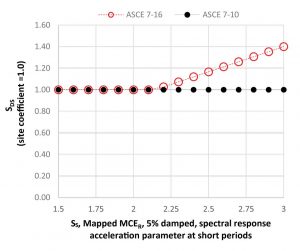ASCE 7-16 Revised Capping Provision for Short Period Regular Structures
Design forces for short period, regular structures, five stories and less in height, in high seismic hazard areas, are permitted to be designed for less seismic force than would otherwise be required by use of the mapped ground motion parameters. The reduced force levels are permitted under ASCE 7 Minimum Design Loads and Associated Criteria for Buildings and Other Structures, Section 12.8.1.3, which caps the level of design force for such structures based on engineering judgment formed by observations of good seismic performance in prior California earthquakes.
The concept of the cap first appeared in the 1997 Uniform Building Code (UBC) with permissible use of a reduced near-source factor under certain conditions. An alternative form of the cap appeared in the 2000 NEHRP Recommended Provisions for Seismic Regulations for New Buildings and Other Structures. This is the basis of language capping maximum values of the calculated seismic response coefficient, Cs, for short period, regular structures five stories and less in height in ASCE 7-02 through ASCE 7-10. For reference, ASCE 7-10 provisions follow:
12.8.1.3 Maximum SS Value in Determination of Cs. For regular structures five stories or less above the base as defined in Section 11.2 and with a period, T, of 0.5 s or less, Cs is permitted to be calculated using a value of 1.5 for SS.
In development of ASCE 7-16, which is referenced in the 2018 International Building Code (IBC), the cap language was judged to be overly broad when considering original intent based on observations of good seismic performance of certain regular buildings. The revised capping provision of ASCE 7-16 more narrowly scopes applicability. For example, use of the capping provision is not allowed for Risk Category III and IV structures, and on sites classified as E or F. The force reduction is also limited to 30%, which is more in line with the maximum level of force reduction permissible under the 1997 UBC. Additionally, the applicability of the cap based on number of stories is revised to count each mezzanine level as a story and by counting the number of stories relative to the grade plane. The phrase “above the base” for counting number of stories in ASCE 7-10 allowed for interpretation that the story limit applied to the number of stories above the top of a rigid podium. For ease of reference, provisions appearing in ASCE 7-16 follow:
12.8.1.3 Maximum SDS Value in Determination of Cs and Ev. The value of Cs and Ev are permitted to be calculated using a value of SDS equal to 1.0, but not less than 70% of SDS as defined in Section 11.4.5, provided that all of the following criteria are met:
- The structure does not have irregularities, as defined in Section 12.3.2;
- The structure does not exceed five stories above the lower of the base or grade plane as defined in Section 11.2. Where present, each mezzanine level shall be considered a story for the purposes of this limit;
- The structure has a fundamental period, T, that does not exceed 0.5 s, as determined using Section 12.8.2;
- The structure meets the requirements necessary for the redundancy factor, ρ, to be permitted to be taken as 1.0, in accordance with Section 12.3.4.2;
- The site soil properties are not classified as Site Class E or F, as defined in Section 11.4.3; and
- The structure is classified as Risk Category I or II, as defined in Section 1.5.1.
The design 5% damped spectral response acceleration parameter at short periods, SDS, in accordance with capping provisions of ASCE 7-16 and ASCE 7-10 used to calculate seismic base shear, is shown in the Figure.

Comparison of SDS in accordance with capping provisions of ASCE 7-16 and ASCE 7-10 Section 12.8.1.3. (Fa = 1.0).
Under the revised capping provisions of ASCE 7-16 Section 12.8.1.3, design seismic forces for short period, regular structures, five stories and less in height are increased in areas of high seismic hazard when compared to ASCE 7-10. The increase in forces is largest for areas of greatest seismic hazard. The revision does not affect design seismic forces in low seismic hazard areas. While seismic design forces are higher for these structures in high seismic areas, the changes in the applicability of the provisions based on clarifications to agree with original intent are likely the most significant. For example, under the revised capping provisions of ASCE 7-16 Section 12.8.1.3, a five-story structure with two levels of mezzanines is considered a structure with seven stories for the purpose of this cap and would exceed the five-story limit for applicability of reduced seismic design forces. Similarly, a five-story structure over a two-story rigid podium, in accordance with the two-stage analysis procedure, is considered a structure with seven stories for the cap and would also exceed the five-story limit for applicability of reduced seismic design forces. Additional information on ASCE 7-16 Section 12.8.1.3 can be found in ASCE 7-16 Commentary.
Designers of residential multi-story light-framed over-podium structures should check with the local jurisdiction to see if they have adopted any of the ASCE 7-16 Section 12.8.1.3 requirements early. Some jurisdictions are considering adopting ASCE 7-16 Section 12.8.1.3 requirements now rather than waiting until the local adoption of the 2018 IBC, which adopts the ASCE 7-16 design requirements by reference. For example, the City of Los Angeles has already adopted the ASCE 7-16 Section 12.8.1.3 changes as part of their 2017 Los Angeles City Building Code instead of waiting for their next building code adoption cycle in 2020, knowing of the significant changes forthcoming with ASCE 7-16.▪
